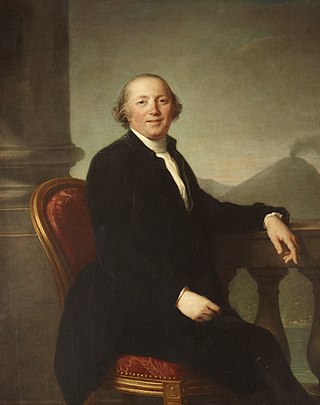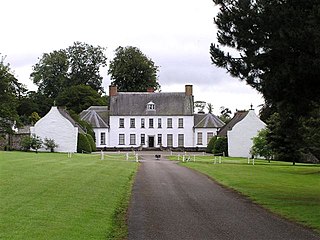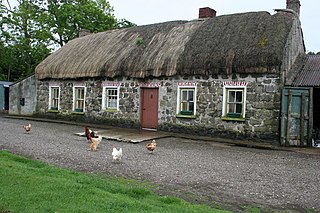
Drenagh is a 19th-century house and gardens near Limavady, County Londonderry, Northern Ireland. Drenagh has been the home of the McCausland family since 1729, and the present house was built in 1835. It was the first major work by Charles Lanyon, known for his work in Belfast. The gardens include features from the 18th century, as well as an extensive 19th-century Italian garden and elements added in the 1960s. The house is a Grade A listed building.

Marquess of Bristol is a title in the Peerage of the United Kingdom held by the Hervey family since 1826. The Marquess's subsidiary titles are Earl of Bristol, Earl Jermyn, of Horningsheath in the County of Suffolk (1826), and Baron Hervey, of Ickworth in the County of Suffolk (1703). The Hervey barony is in the Peerage of England, the earldom of Bristol in the Peerage of Great Britain and the Jermyn earldom in the Peerage of the United Kingdom. Earl Jermyn is used as courtesy title by the Marquess's eldest son and heir. The Marquess of Bristol also holds the office of Hereditary High Steward of the Liberty of St Edmund. The present holder of these titles is Frederick Hervey, the 8th Marquess and 12th Earl of Bristol.

Frederick Augustus Hervey, 4th Earl of Bristol,, was an 18th-century Anglican prelate.

Springhill is a 17th-century plantation house in the townland of Ballindrum near Moneymore, County Londonderry in Northern Ireland. It has been the property of the National Trust since 1957 and, in addition to the house, gardens and park, there is a costume collection and a purported ghost. It is open from March to June, and September on weekends, and is open to the public seven days a week during July and August.

Castleblayney is a town in County Monaghan, Ireland. The town had a population of 3,607 as of the 2016 census. Castleblayney is near the border with County Armagh in Northern Ireland, and lies on the N2 road from Dublin to Derry and Letterkenny.

Ickworth House is a country house at Ickworth, near Bury St Edmunds in Suffolk, England. It is a neoclassical building set in parkland. The house was the residence of the Marquess of Bristol before being sold to the National Trust in 1998.

Mussenden Temple is a small circular building located on cliffs near Castlerock in County Londonderry, high above the Atlantic Ocean on the north-western coast of Northern Ireland.

Castlerock is a seaside village in County Londonderry, Northern Ireland. It is five miles west of Coleraine, and part of Causeway Coast and Glens district. It is very popular with summer tourists, with numerous apartment blocks and two caravan sites. Castlerock Golf Club has both 9-hole and 18-hole links courses bounded by the beach, the River Bann and the Belfast to Derry railway line. The village had a population of 1,287 people at the 2011 census, and is where near by village Articlave F.C play their home games.

Belfast Castle is a mansion located in Cave Hill Country Park in Belfast, Northern Ireland, in a prominent position 400 feet (120 m) above sea level. Its location provides unobstructed views over the City of Belfast and Belfast Lough. There have been several different structures called 'Belfast Castle' over the centuries, located on different sites. The current 'castle' is a Victorian structure, built between 1867 and 1870 on the slopes of Cave Hill, and is listed as being Grade B+. The main entrance into the Belfast Castle Demesne is now where Innisfayle Park meets Downview Park West, just off the Antrim Road. The original main entrance into the current demesne was formerly on the Antrim Road itself, where Strathmore Park now meets the Antrim Road.
Downhill is a small village and townland near Castlerock in County Londonderry, Northern Ireland. It is situated within Causeway Coast and Glens district. It was visited by the Lewis brothers in their childhood, when, in July 1901, their nurse took them for a visit while on a holiday in Castlerock.

Castle Ward is an 18th-century National Trust property located near the village of Strangford, in County Down, Northern Ireland, in the townland of the same name. It overlooks Strangford Lough and is 7 miles from Downpatrick and 1.5 miles from Strangford.

Castlerock railway station serves the villages of Castlerock, Articlave and their surrounding hamlets in County Londonderry, Northern Ireland. Walkers use the station to reach Mussenden Temple, Downhill Strand and Benone.

Ballyscullion is a small village and civil parish in County Londonderry, Northern Ireland. In the 2001 Census it had a population of 291 people. The civil parish of Ballyscullion covers areas of County Antrim as well as County Londonderry. The village is situated within Mid-Ulster District.

Dartrey Forest is a forest and estate near Rockcorry in north-west County Monaghan, Ireland. It was formerly part of the Barony of Dartrey and was the country estate of the Dawson family, who had the title Earl of Dartrey from 1866 to 1933.

The so-called Temple of Vesta is a small circular Roman temple in Tivoli, Italy, dating to the early 1st century BC. Its ruins are dramatically sited on the acropolis of the Etruscan and Roman city, overlooking the falls of the Aniene and a picturesque narrow gully.

Banagher is a parish in County Londonderry, Northern Ireland. The parish is made up of the medieval parish of Banagher and parts of the ancient parish of Boveva and the townland of Tireighter and Park, once in the parish of Cumber. Banagher has many ancient monuments, including churches, holy wells, standing stones and chambered graves.
The Mussenden Temple and Downhill Demesne is a National Trust property consisting of Downhill Castle and its estate, which includes the Mussenden Temple. A popular wedding destination and viewing point.
Ballyscullion House refers to two country houses built for the Hervey family near Bellaghy in County Londonderry, Northern Ireland, close to Lough Beg at north-west corner of Lough Neagh.
Sir Henry Hervey Aston Bruce, 1st Baronet was an Irish priest.
Boom Hall is a house and demesne in Derry, Northern Ireland. Lying close to the west bank of the River Foyle, a fort was constructed on the site during the English Civil War. During the Williamite War in Ireland a boom was constructed across the river to try to prevent Williamite forces relieving the Siege of Derry. A two-storey country house was subsequently built on the site by the Alexander family and named after this boom. The estate was later leased to a number of people until a leasehold was sold to Daniel Baird in 1849 by The 3rd Earl of Caledon. This was inherited by Daniel Baird Maturin-Baird who also purchased the freehold from the Alexanders. Boom Hall was again let to a number of different people, with Michael Henry McDevitt living there from 1924. During the Second World War, the demesne was used by the Admiralty and a number of temporary huts were built there. McDevitt purchased the freehold in 1949 and the house was renovated. It fell into disuse in the 1960s and was almost destroyed by fire in the 1970s. Part of the estate was used for the construction of the Foyle Bridge.
















